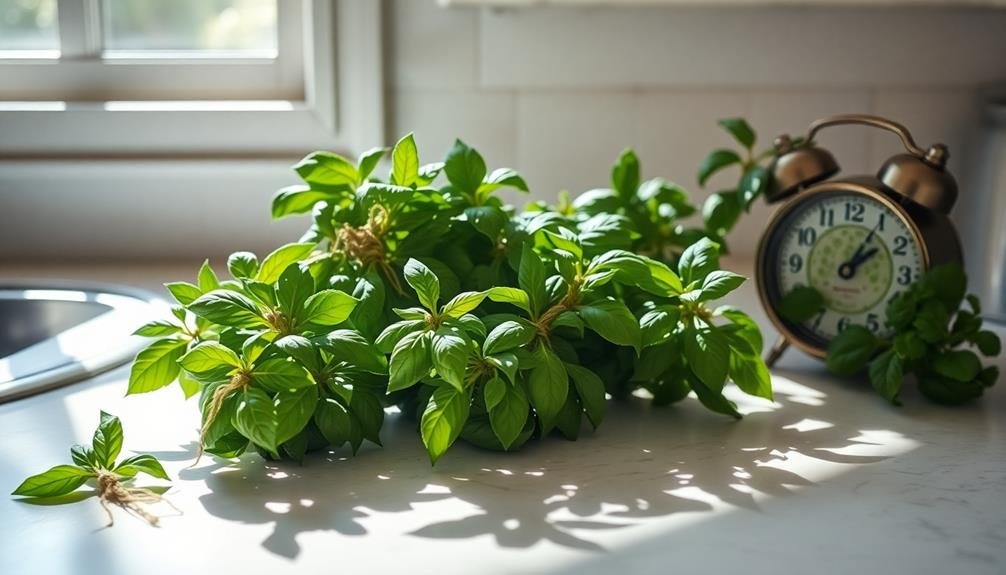To brew perfect tea, you've got to nail the drying times for basil, mint, and chamomile. For basil, hang stems upside down in a dark, ventilated area for 1-2 weeks, or use a dehydrator for 4-6 hours. Mint dries best when you hang bunches upside down in a cool place, checking daily until the leaves crumble easily. This takes about a week, but a dehydrator can speed it up to a few hours. For chamomile, air drying takes 1-2 weeks, while a dehydrator speeds it up to 2-4 hours. There's so much more to explore when it comes to perfecting your tea!
Basil Drying Time

When it comes to drying basil, timing is key to capturing its vibrant flavor. You want to harvest your basil when the leaves are at their peak—generally just before the plant starts to flower. This guarantees you get the most aromatic and flavorful leaves. Aim to gather your basil in the morning after the dew has dried but before the sun gets too hot.
Once you've collected your basil, the drying process begins. You can choose to air dry, use a dehydrator, or even your oven. If you're air drying, tie the basil stems together and hang them upside down in a dark, warm, and well-ventilated spot. This method usually takes about one to two weeks, depending on humidity levels.
If you're short on time, a dehydrator works well, typically taking around four to six hours at a low temperature. Alternatively, using an oven set to the lowest setting might only take 30 minutes to an hour.
Whichever method you choose, make certain the leaves are completely dry and crumbly before storing them in an airtight container to preserve their wonderful flavor.
Mint Drying Time
Harvesting mint at the right time guarantees maximum flavor for your tea. Once you've gathered your mint, it's essential to dry it properly to preserve its aromatic oils. The ideal drying time for mint typically ranges from 1 to 2 weeks, depending on the drying method you choose.
If you're using the air drying method, tie a small bunch of mint stems together and hang them upside down in a cool, dark, and well-ventilated area. Make sure the location isn't too humid, as this can lead to mold.
Check your mint daily; you'll know it's ready when the leaves feel crisp and crumble easily.
For faster results, consider using a dehydrator. Set it to a low temperature, around 95°F to 115°F (35°C to 46°C), and spread the mint leaves evenly on the trays. This method can reduce drying time to just a few hours.
Regardless of your method, store your dried mint in an airtight container away from direct sunlight. This way, you'll maintain its flavor and potency, ensuring your mint tea is delightful every time you brew a cup!
Chamomile Drying Time

To enjoy the soothing qualities of chamomile tea, drying the flowers correctly is essential. Proper drying guarantees you maintain the aromatic oils and flavors that make chamomile so delightful. Here's what you need to know about chamomile drying time:
- Harvesting: Pick chamomile flowers when they're fully open, usually in late spring to early summer.
- Cleaning: Gently rinse the flowers to remove any dirt or insects, then pat them dry with a towel.
- Drying Method: Choose between air drying or using a dehydrator. If you're air drying, hang the flowers upside down in a dark, dry place with good air circulation.
- Drying Time: Expect it to take about 1-2 weeks for air drying. If you're using a dehydrator, it typically only takes 2-4 hours at a low temperature.
Once dried, store your chamomile flowers in an airtight container away from light.
This way, you'll retain their flavor and aroma for your perfect cup of tea whenever you need a moment of relaxation. Enjoy your brewing!
Frequently Asked Questions
Can I Dry Herbs in the Microwave?
Yes, you can dry herbs in the microwave! Just place them between paper towels and heat in short intervals, checking frequently. This method's quick, but be careful not to overcook your herbs. Enjoy experimenting!
What Is the Best Storage Method for Dried Herbs?
To store dried herbs effectively, use airtight containers like glass jars or vacuum-sealed bags. Keep them in a cool, dark place to maintain flavor and potency. Avoid direct sunlight or moisture to preserve their quality.
How Can I Tell if Herbs Are Fully Dried?
To tell if herbs are fully dried, check their texture. They should feel crisp and crumble easily. Also, a strong aroma indicates they're ready. If they're still moist, give them more time to dry completely.
Are There Specific Herbs That Shouldn't Be Dried?
Certain herbs, like basil and cilantro, tend to lose flavor when dried. You'll want to use them fresh for the best taste. Some herbs, like rosemary and thyme, dry well and maintain their essence.
How Does Humidity Affect Herb Drying Times?
Humidity greatly impacts herb drying times. When humidity's high, moisture in the air slows down the drying process, making it take longer. Conversely, lower humidity speeds up drying, ensuring your herbs retain their quality and flavor.
In Summary
Now that you know the ideal drying times for basil, mint, and chamomile, you can confidently create your own perfect teas at home. Just remember to keep an eye on those drying herbs to guarantee they reach the right texture and flavor. With a bit of practice, you'll enjoy delicious, aromatic brews that showcase the true essence of each herb. So, get started on your herbal journey and savor the delightful results!





Leave a Reply